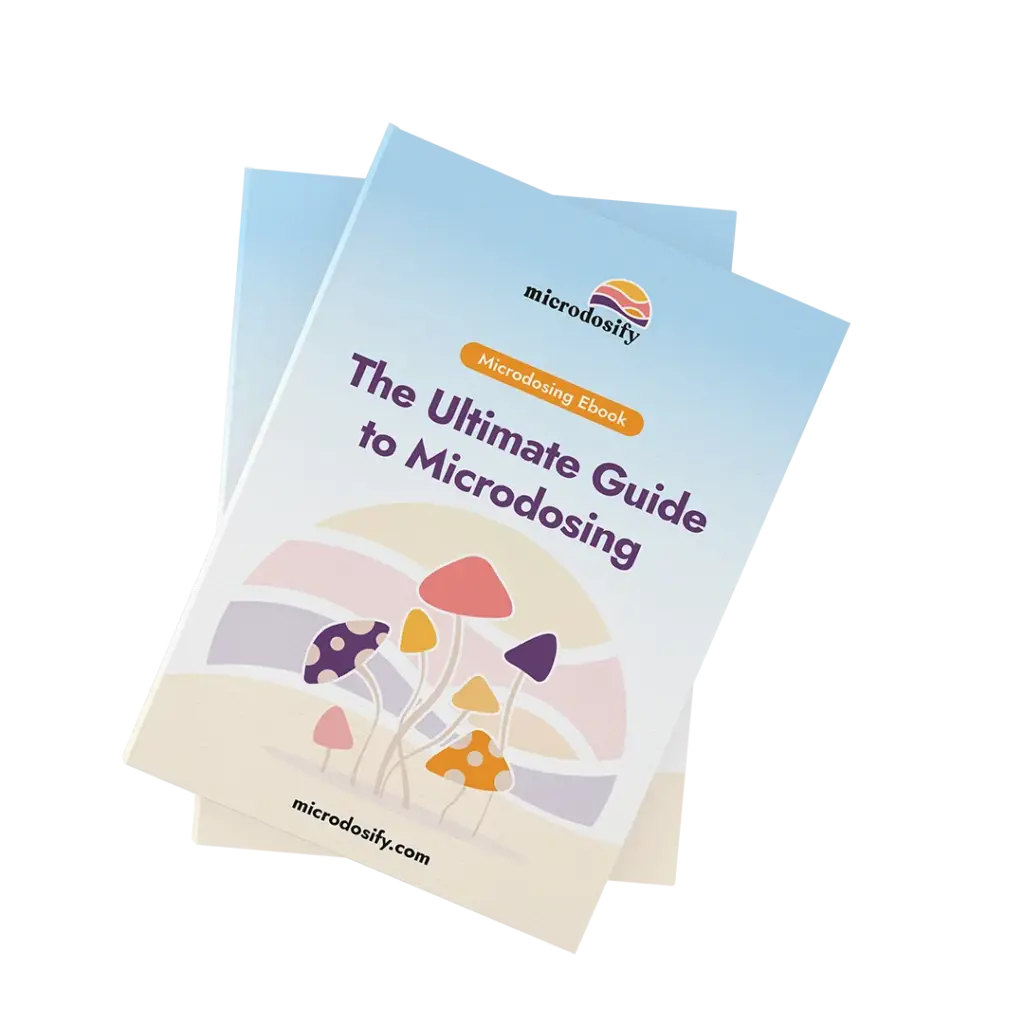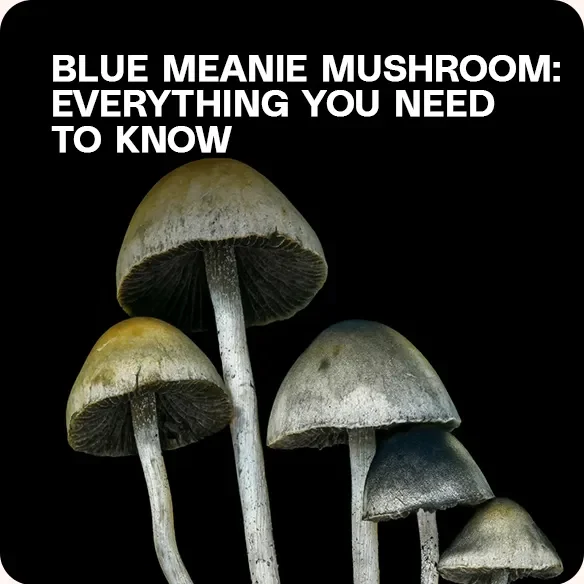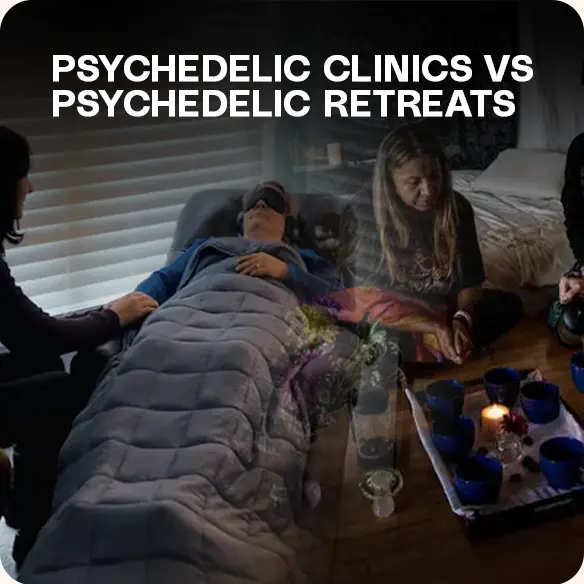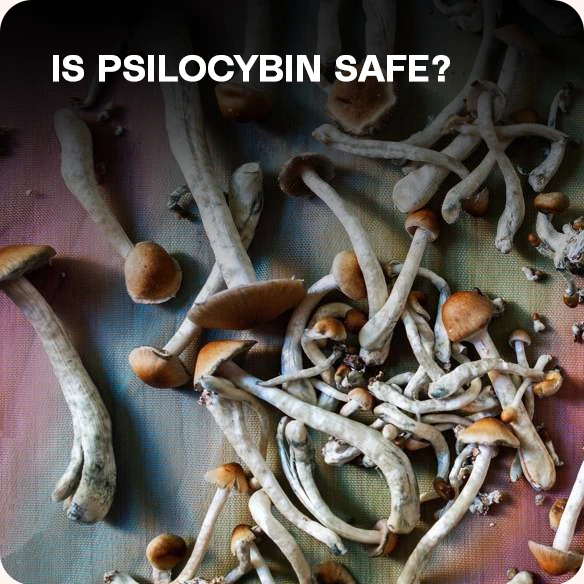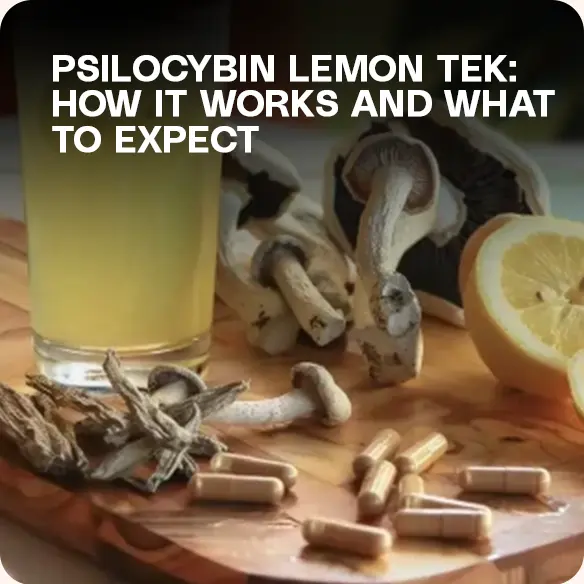Blue Meanie Mushrooms are small, thin mushrooms that grow in warm places, often in cow fields, and they bruise blue when you touch them—hence the name.
You might also hear people call them Pan cyan, Copes, or just Blue Meanies. It’s all the same mushroom.
Just one thing to watch out for: there’s also a type of Psilocybe cubensis called Blue Meanies, but it’s not the same.
If you’re new to mushroom species, check out our guide on the strongest magic mushroom strains.
The Copelandia ones (Panaeolus cyanescens) are way stronger and grow differently.
So if someone mentions Copelandia or Blue Meanies, chances are they’re talking about Panaeolus cyanescens, one of the most potent magic mushrooms out there.
Where Do Blue Meanies Grow?
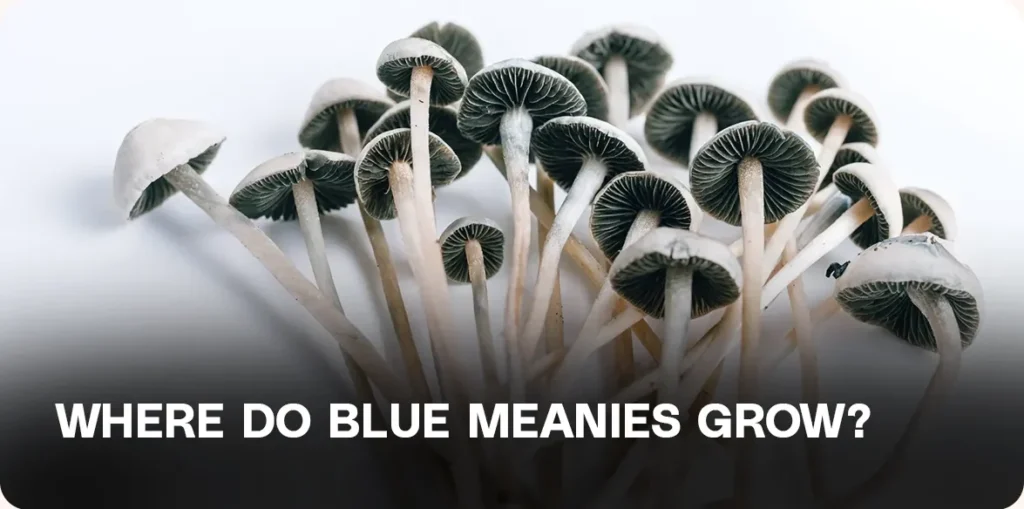
You don’t need to travel far and wide to find Blue Meanies—as long as the climate’s right, they tend to show up on their own.
These mushrooms love warm, humid places, especially in tropical and subtropical regions.
You’ll find them in Florida, especially in the southern part of the state, where they can grow almost year-round thanks to the warm weather.
They’re also common in Hawaii, where they were likely introduced through imported cattle in the 1800s.
Here are a few more places where Blue Meanies are regularly spotted:
- Mexico (especially in Oaxaca and Veracruz)
- Brazil, Colombia, and Peru
- India, Thailand, Bali, and Malaysia
- Australia, especially in Queensland
- South Africa
- Caribbean Islands like Jamaica and the British Virgin Islands
- France and Italy (during warm, rainy months)
In the U.S., aside from Florida, they also pop up along the Gulf Coast, including parts of Texas, Louisiana, Mississippi, and Alabama, mostly during the rainy season in late spring through early fall.
Do Blue Meanies Really Grow on Cow Dung?
Yes, they absolutely do.
Blue Meanies are one of those mushrooms that thrive in cow or horse dung—which makes pastureland their favorite hangout.
If you’re walking through a field after some heavy rain, especially in a tropical climate, there’s a good chance you might spot them growing straight out of old cow pies.
It sounds weird, but that’s just their thing.
And it’s also why they’re sometimes called “dung-loving mushrooms.”
They’ve evolved to grow in that environment, and they do really well there—especially when the temperature is warm and there’s enough moisture.
So if you’re foraging or just curious, remember: cow fields, humid weather, and warm temps are your best clues for finding Blue Meanies in the wild.
How Can You Tell Blue Meanies Apart from Other Mushrooms?
Blue Meanies are small and easy to miss if you don’t know what to look for.
They don’t have bright colors or a weird shape, but they’ve got a few key features that help them stand out—especially if you’re checking mushrooms growing on dung.
When they’re young, Blue Meanies have light brown caps, but as they mature, those caps fade to a whitish or pale gray color.
The caps are small—usually between 1.5 to 4 cm wide—and shaped like a little bell or umbrella.
When the weather is dry, they often crack or split slightly on top.
One thing you’ll notice right away is the blue bruising.
If you pinch the cap or stem, it usually turns blue or blue-green where it’s been touched. That’s a big clue you’ve found something with psilocybin in it.
The gills underneath are dark gray to black and look spotty or speckled, which is why mushrooms in this group are sometimes called “mottlegills.”
And the spore print? Jet black—another good sign it’s a Panaeolus species.
The stems are thin and long, usually white or pale like the cap, and often have a powdery look. They’re not hollow and stay straight, not wavy or curvy like some other types.
To stay safe, here’s a guide on what a bad trip looks like and how to avoid it.
What Makes Blue Meanies Different from Psilocybe cubensis?
At a glance, people sometimes mix up Blue Meanies and Psilocybe cubensis, especially since they both grow in pastures. But once you know the details, they’re pretty easy to tell apart.
- Size: Blue Meanies are much smaller and thinner than cubensis. Cubensis mushrooms are chunky and stocky in comparison.
- Color: Cubensis caps are usually golden or caramel-colored. Blue Meanies start brownish but fade to pale gray or off-white.
- Potency: Blue Meanies are 2 to 3 times stronger than most cubensis strains, so dosing is very different.
- Gills: Cubensis gills are more evenly colored, while Blue Meanies have that mottled, patchy look.
- Bruising: Both bruise blue, but it tends to show up more intensely and quickly on Blue Meanies.
If you’re used to spotting cubensis, just think: Blue Meanies are like the skinnier, sneakier cousins.
What Are Common Blue Meanie Lookalikes You Should Avoid?
There are a few mushrooms that can look like Blue Meanies at first glance—especially if you’re just getting started. Here are a few to watch out for:
- Protostropharia semiglobata (Dung Roundhead): Grows on dung too, but has a yellow-brown cap and a ring on the stem. Not deadly, but not something you want to eat.
- Panaeolus antillarum: Looks similar but has a thicker cap, is lighter in color, and doesn’t bruise blue. It’s not active, but it won’t hurt you either.
- Tubaria furfuracea: Grows on wood chips, not dung, and has an orange-brown cap with a lighter spore print.
- Pholiotina rugosa & Galerina marginata: These are dangerous and can be deadly. They grow on wood, not dung, and have rusty orange spore prints—not black.
The best tips? Stick to dung-loving mushrooms with blue bruising and jet black spore prints. And if you’re unsure—don’t eat it.
How Strong Are Blue Meanies Compared to Other Shrooms?
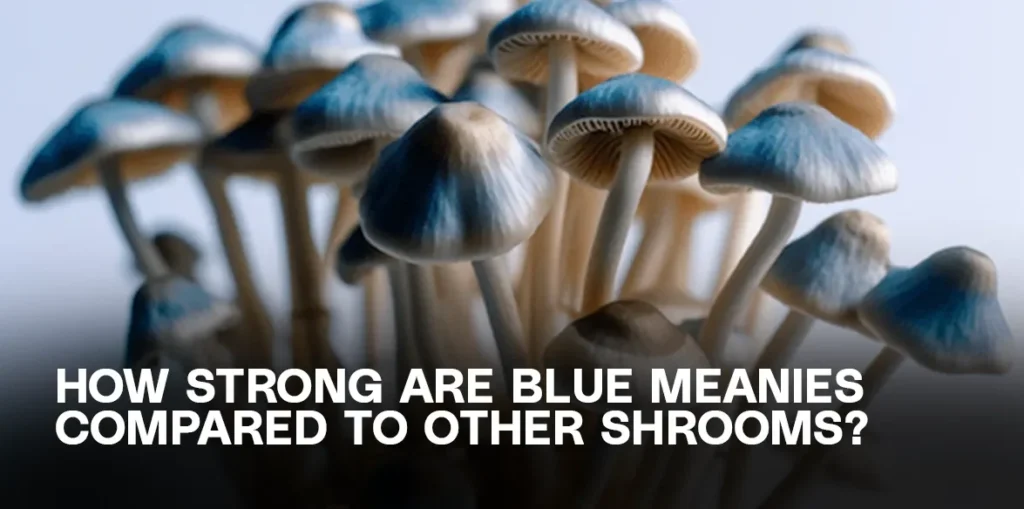
Blue Meanies can contain two to three times more psilocybin than Psilocybe cubensis.
In some cases, they’ve even tested at over 4% total alkaloids (psilocybin + psilocin), which is extremely high for any mushroom.
To give you a rough idea:
- Psilocybe cubensis usually has around 0.6% to 1.2% combined alkaloids.
- Blue Meanies often come in at 1.5% to 3%, and sometimes more.
That’s a huge difference, especially if you’re dosing by grams.
Taking 1 gram of Blue Meanies is not the same as taking 1 gram of cubensis. That mistake has caught a lot of people off guard.
Why Do They Hit Harder Even in Small Doses?
It’s not just the amount of psilocybin—it’s also how the mushroom is made up.
Blue Meanies often contain more psilocin, which is the form your body actually uses to make you trip.
Psilocybin has to be converted into psilocin first, so mushrooms with more psilocin can hit faster and stronger.
That’s why many people say Blue Meanies feel more intense, even at small doses. The trip can come on quickly, feel more vivid, and last a bit longer too.
To understand the neurological mechanism behind this, read about how psilocybin rewires the brain.
How Much Should You Take If You’re New to Them?
Start small, like 0.5 to 1 gram (dried). That might not sound like much if you’re used to cubensis, but trust us, it’s enough.
Here’s a rough guide:
- 0.3 to 0.5g: Light body buzz, maybe some giggles or mild visuals
- 0.5 to 1g: Noticeable trip—colors shift, deep thoughts, emotional waves
- 1.5g and up: Very strong. For experienced trippers only
Always give the dose time to kick in before taking more.
With potent mushrooms like these, even a small extra amount can take things from fun to overwhelming real quick.
Can You Grow Blue Meanies at Home?
Yep, you can definitely grow Blue Meanies at home, but fair warning—it’s not as easy as growing Psilocybe cubensis.
If cubensis is like growing a houseplant, Blue Meanies are more like raising a bonsai tree.
It takes more patience, more attention, and a bit of trial and error.
They don’t like to be too dry, too cold, or too stuffy. And they’re not as forgiving if something goes slightly off.
On top of that, they absolutely need a casing layer to fruit well, which isn’t always necessary with cubensis.
They also take longer to pin and don’t pump out as many mushrooms per flush. But the results are worth it.
What Kind of Setup and Care Do They Need?
Here’s what a good Blue Meanies grow needs:
- Warm temps: They like it around 80–85°F (27–29°C), a bit warmer than cubensis.
- High humidity with good airflow: Not too wet, not too stale. You’ll probably be misting and fanning more often.
- Manure-based substrate: They grow best on field-aged cow or horse manure, either on its own or mixed with something like coir or straw.
- Thin casing layer: A top layer of moist material like peat or vermiculite helps them fruit properly and hold moisture.
- Patience: They don’t fruit as fast or as heavily as cubensis, but they make up for it in strength.
Some growers use a modified monotub setup with a heated water bath underneath to keep the temp steady—kind of like a mushroom sauna.
Others go with a double-tub GordoTEK style grow, which is designed specifically to hit the sweet spot for these mushrooms.
If you’ve already had success with cubensis and want a next-level grow project, Blue Meanies are a solid challenge. Just expect a learning curve.
Are Blue Meanies Worth It?
Blue Meanies are absolutely worth it.
They hit harder than your average shrooms and tend to feel more “sharp” or “crisp” compared to cubensis.
A lot of people say they feel more visual, more energetic, and more intense overall.
But with that strength comes a bit of responsibility.
For newcomers, understanding the benefits of microdosing may be a better entry point than diving into high-potency varieties
If you’ve never tried mushrooms before, it’s probably smart to begin with something milder like cubensis.
Blue Meanies don’t mess around—even small doses can catch people off guard if they’re not prepared.
That said, if you’re experienced or just careful with your dosage, plenty of people have great first trips with Blue Meanies. The key is to start low and go slow.
